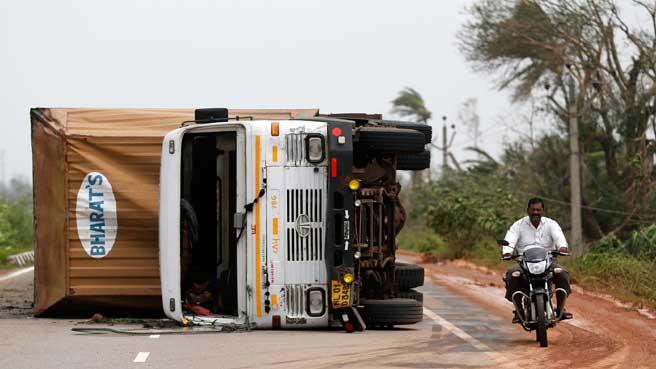October 14, 2013
Cyclone Phailin, India's fiercest storm in 14 years, smashed into the coastline of Andhra Pradesh and Odisha states over the weekend

October 14, 2013
Cyclone Phailin, India's fiercest storm in 14 years, smashed into the coastline of Andhra Pradesh and Odisha states over the weekend

As meteorologists warned last week of a monster storm ploughing towards India's east coast, the country's disaster preparedness teams snapped into action, pre-positioning emergency response teams and supplies, and evacuating nearly a million people – ultimately saving countless lives.
The impressive show of disaster preparedness is thanks in large part to the lessons learnt after a powerful cyclone hit the country and killed 10,000 people in 1999, and the plans implemented in the years since, say aid workers and disaster experts.
"Credit is due to those who have been involved in efforts to reduce the scale of vulnerability to disasters across India," said Tom Mitchell, head of climate change at the Overseas Development Institute in London.
"The low loss of life, following the strongest storm ever measured in the Bay of Bengal, would almost certainly not have been possible without learning lessons from previous cyclones and tsunamis that have hit this coastline."
Cyclone Phailin, India's fiercest storm in 14 years, smashed into the coastline of Andhra Pradesh and Odisha states over the weekend, flooded swathes of farmland and ripped part tens of thousands of mud-and-thatch homes – but surprisingly, only 15 people have been reported dead.
Early warnings which started five days before the storm's arrival, the pre-positioning of food rations and packaged drinking water in shelters, and the orderly – and sometimes forceful – evacuation of close to one million people saved many lives, said aid workers.
As Phailin approached, authorities cancelled the holidays of civil servants during the popular Hindu Dussehra festival, deployed disaster response teams with heavy equipment and positioned helicopters and boats for rescue and relief operations.
Trains and flights were cancelled, roads barricaded and helplines and control rooms set up. Satellite phones and generators were dispatched to the heads of districts to ensure they remained in contact with the state capital.
The army, navy and air force were put on standby, and power and telecoms companies were instructed to be ready to restore damaged infrastructure as soon as possible after the storm.
Efforts to save people's livelihoods were also taken. Specific warnings were given to fishermen not to venture out to sea and to put their boats in safe places, while farmers were advised to harvest their standing crops.
"It's nothing short of a miracle that so many lives were spared. We were expecting the worst, but it just shows that all the time and investment put into preparing for such disasters by the authorities, civil society organizations and communities has paid off," said Save the Children's Devendra Tak.
India is one of the most disaster-prone countries in the world, and many of its 1.2 billion people live in areas vulnerable to natural hazards such as floods, cyclones, droughts and earthquakes.
The 1999 super cyclone which thrashed Odisha with wind speeds of 300 km per hour – leaving more than a million homeless – was a wake-up call to authorities as well as humanitarian agencies, say disaster experts.
With meteorologists warning that climate change will bring more severe natural calamities to the Indian subcontinent, states like Odisha and Andhra Pradesh have since invested heavily in disaster risk reduction projects.
Both states have their own disaster management departments and have built hundreds of cyclone shelters across the coast. Technological advances have been made with models that forecasters can use to accurately predict weather for seven days in advance.
Humanitarian organizations such as the Indian Red Cross have also played an instrumental role – mobilizing thousands of volunteers across the cyclone-prone region who are trained in first aid and can support evacuations and aid distributions.
Drills are regularly organised so people know what to do when an alert is issued – locking up their homes, keeping their cattle in safe places and taking only a few clothes and important documents with them.
'Christian Aid and its local partner organisations have been working with the coastal communities in Odisha and Andhra Pradesh for almost two decades and have established an extensive network of disaster management task forces all along the coast,' said a statement from UK-based charity Christian Aid.
'They have increased the resilience of coastal communities, preparing them for emergencies such as Cyclone Phailin, as well as teaching them about life-saving search and rescue activities, and the availability of stockpiles of emergency relief supplies.'
Around 76 percent of India's coastline is prone to cyclones and tsunamis, while 59 percent of the country is vulnerable to earthquakes, 10 percent to floods and river erosion, and 68 percent to droughts.
But not all states in India are as prepared as Odisha and Andhra Pradesh, say disaster experts, adding that some have not even established disaster management departments or those that have, are not functioning.
For example, unprecedented rainfall in June wreaked havoc across the Himalayan state of Uttarakhand, causing rivers and glacier lakes to overflow and triggering massive landslides – a catastrophe that many termed a 'Himalayan Tsunami'.
Almost 6,000 missing people are presumed dead, and the devastation has disrupted the lives of two million people – one-fifth of Uttarakhand's population.
The failure of state authorities to act on early warnings given by the weather office and organise timely evacuations in the popular Hindu pilgrimage area were blamed for the staggering death toll.
The construction of hydroelectric dams, rampant deforestation and the spread of unregulated buildings along river banks worsened the impact, add environmentalists.
Experts say more frequent and intense extreme weather events caused by global warming mean countries like India must improve their planning and reduce the potential impact of disasters before they occur.
'Odisha and Andhra Pradesh passed the acid test on cyclone Phailin, but not all of India is that well-prepared,' said Unni Krishnan, head of disaster response for children's charity Plan International.
'Other states, where millions of people are at risk, also need to have the same level of preparedness.'
Courtesy: Reuters
















































































































